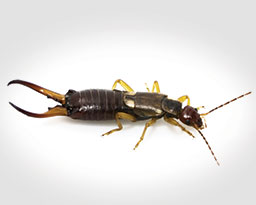FIND YOUR LOCAL
ARROW SERVICE CENTER
Order Dermaptera
Earwigs got their name from the myth that they crawl into sleeping people's ears and tunnel into their brains. The long cerci, or clippers, on their backsides easily identify an earwig.

| Color | Dark brown |
| Legs | 6 |
| Shape | Long, narrow |
| Size | 1" |
| Antennae | True |
Contrary to folklore, earwigs do not crawl into ears and eat peoples' brains at night. They do not spread diseases, but their menacing appearance can be alarming to a homeowner.
Remove harborage sites such as leaf piles, mulch piles or other vegetation. Seal cracks and crevices well to prevent structural entry.
Earwigs feed on leaves, flowers, fruits, mold and insects at night. Earwigs typically hide during the day.
Earwigs live together outdoors in large numbers. They can be found under piles of lawn debris, mulch or in tree holes. They gain entry to a structure through exterior cracks.
Earwigs are attracted to light and humidity. They can also be brought into a building accidentally in boxes, bundles of paper, books, or plants.
After you submit the information below, a trained professional in your area will get in touch within 1-2 business days to set up a date & time that is convenient for you.